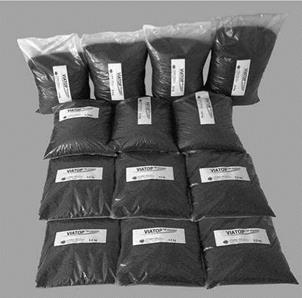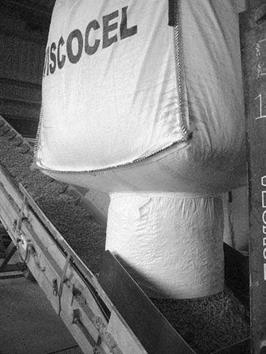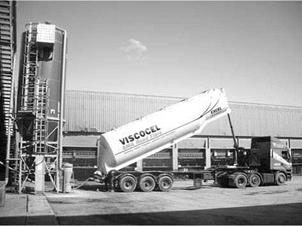Packing and Delivery Forms
Loose fibers are packed in self-shrinkable plastic bags. They are thrown into a mixer intact and the film melts into the binder during mixing. Granulated cellulose fibers may be bagged like other fibers (Figure 4.7) or packed in big-bags (Figure 4.8). Both loose and granulated fibers can be supplied in autotankers (Figure 4.9).
|
FIGuRE 4.7 Granulated stabilizer in PE bags of various mass—from 3 to 10 kg. (Photo courtesy of J. Rettenmaier and Sohne GmbH + Co. KG, Germany.) |
|
|
|
The following is a comparison of loose or pelletized fibers and granulated fibers:
• Loose or pelletized fibers, packed in bags of a fixed weight, are easy to throw manually into a pugmill at a batch asphalt plant, though the method is problematic for big contracts, high-output plants, and plants without semiautomatic metering. Loose fibers have their staunch fans, claiming that this type of fiber can be better distributed in a mix and that a lesser amount of them (compared with granulated products) is needed to achieve a similar effect. These fibers do not present any problems during laboratory testing, and they require no extra treatment or equipment. Their disadvantages lie in water absorption, which requires covered storage, and the necessity of manual operations at batching.
• Granulated fibers usually contain the same fibers as loose fibers, except that they have been coated with a binder (or other material), enabling production of granulated products that are 3-4 mm in diameter and 3-5 mm long. The binder coating makes them more water resistant (i. e., less moisture-sensitive). Another advantage of granulated fibers is the option of automatic dosage into the mixer at an asphalt plant, usually through a screw-pneumatic feeder. Granulated fibers do require a suitable temperature and mechanical mixing to release them and allow them to be dispersed properly in the SMA during production, so granulated products must be added at the right moment and mixed properly.
• Another significant issue that should be considered is the susceptibility of fibers to water. It is little wonder that a stabilizer absorbs water if it is meant to absorb binder. A wet stabilizer may harm the mixture considerably (see Chapter 11). Loose fibers or pellets are more sensitive to moisture than the coated granulated products.
• Various combinations of fiber blends have been appearing here and there (e. g., cellulose-mineral and cellulose-polymer). Some of them reveal certain additional features, such as building up the mastic and enhancing its shear strength.
• The amount of fibers in a mix are determined using Schellenberg’s method or other methods (see Section 4.5 and Chapter 8), normally at a level of
0. 3-0.4% (m/m).









Leave a reply